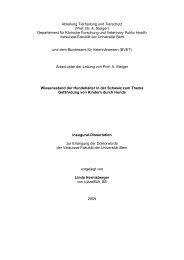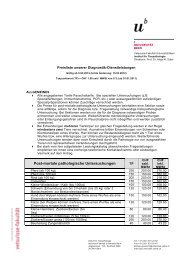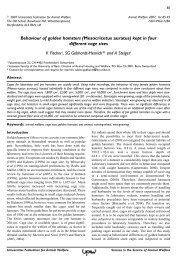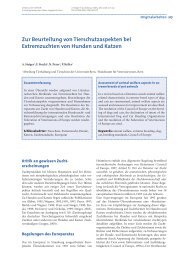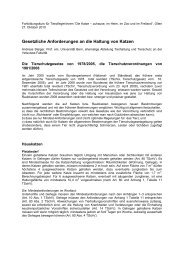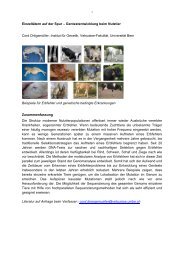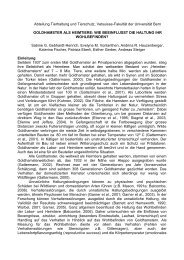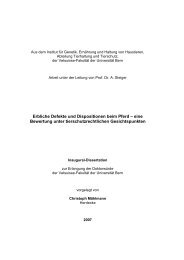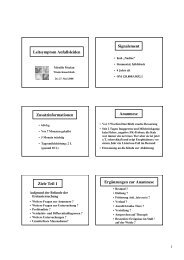Behaviour of golden hamsters (Mesocricetus auratus) - Vetsuisse ...
Behaviour of golden hamsters (Mesocricetus auratus) - Vetsuisse ...
Behaviour of golden hamsters (Mesocricetus auratus) - Vetsuisse ...
You also want an ePaper? Increase the reach of your titles
YUMPU automatically turns print PDFs into web optimized ePapers that Google loves.
all cages. This suggests that even a cage <strong>of</strong> more than 10,000 cm 2 is too small forfemale <strong>golden</strong> <strong>hamsters</strong>.All cages were furnished with the same structures (enrichment). There was alot <strong>of</strong> free space in the big cages, therefore the <strong>hamsters</strong> had the possibility to runmore and faster. But the possibilities <strong>of</strong> preoccupation were the same in all cages.This could be another reason why wire gnawing was performed even in the bigcages. It would be interesting to know whether stereotypic wire gnawing wouldpersist in big cages with more enrichment (e.g. wooden toys, cork caves, climbingpossibilities) and with a change <strong>of</strong> enrichments (Lambert et al., 2005, in mice).Ödberg (1987) found that an increase <strong>of</strong> cage size did not affect stereotyped jumpingin voles, whereas enrichment with twigs reduced it. Spangenberg et. al. (2005)housed rats either singly in small cages (1,092 cm 2 ) with only one black plastic tube,or in groups in larger cages (3,938 cm 2 ) which were provided with more and variousenrichment. Rats in the larger, more enriched cages displayed a more diversebehavioural repertoire which consisted <strong>of</strong> running, climbing and social behaviours.Compared with other studies, all cages in our study were enriched.Litter depth should be considered as another possibility <strong>of</strong> enrichment in<strong>golden</strong> <strong>hamsters</strong>. Hauzenberger (2005) found that <strong>golden</strong> <strong>hamsters</strong> in a litter depth<strong>of</strong> 40 cm showed less stereotypic wire gnawing than <strong>hamsters</strong> housed in 10 cm deeplitter, while in a litter depth <strong>of</strong> 80 cm no stereotypic wire gnawing was observed. All<strong>hamsters</strong> used the deep litter (either 40 cm or 80 cm) as a retreat possibility and builtburrows. Running wheel activity was higher in 10 cm deep litter. This suggests that acombination <strong>of</strong> a big cage with deep litter could be a great improvement <strong>of</strong> thewelfare <strong>of</strong> <strong>golden</strong> <strong>hamsters</strong>.The positive correlation between wire gnawing and climbing can be explainedby the preference <strong>of</strong> some <strong>hamsters</strong> to climb to a particular spot on the front or the23



